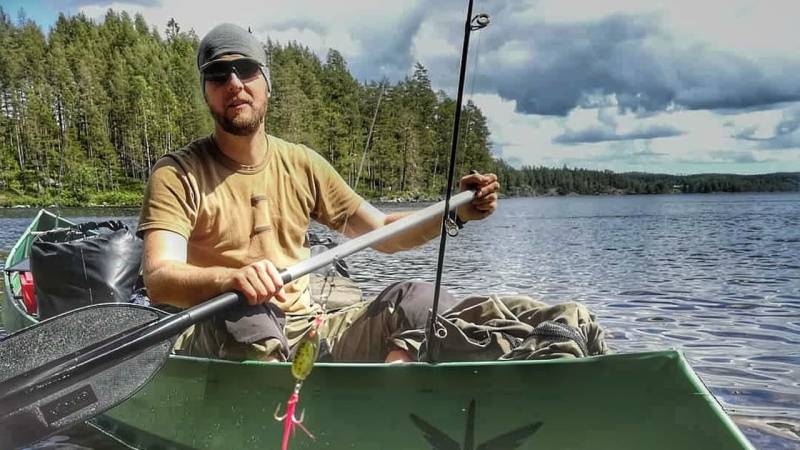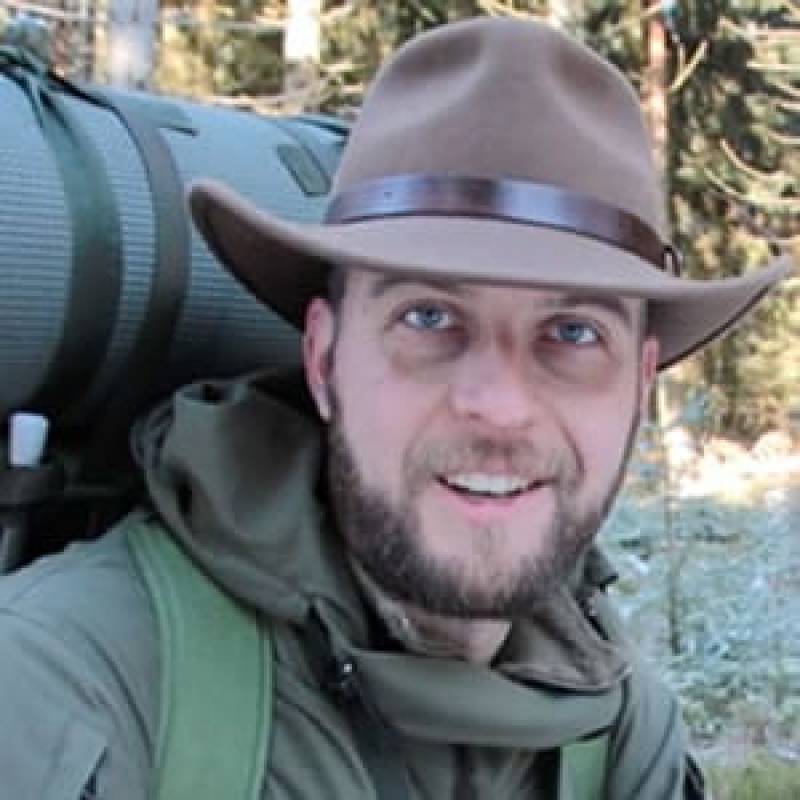
Interview with Martin from the Bushcraft Buddy YouTube channel
👉 The key facts from this guide
- Martin from the YouTube channel "Bushcraft Buddy" shares his passion for Bushcraft and nature through his videos.
- He emphasizes that for him, Bushcraft means freedom, mindfulness, craftsmanship, originality, and a connection with nature.
- Martin prefers to put together his equipment individually according to his needs and warns against cheap "Bushcraft sets" or "survival sets".
- For him, the most difficult Bushcraft technique is bow drilling, especially with materials he finds during a tour.
- He advises taking only the equipment required for a specific tour to avoid unnecessary weight.
- Martin emphasizes that most of the work comes after a tour, when equipment needs to be dried, cleaned, and stored again.
Do you know Martin from the Bushcraft Buddy YouTube channel (yes, he has the same name as me)?
No? Well then, now is your chance to get to know him better.
I met Martin, and he's taking us into his world today.
How did he start his YouTube channel? What excites him about bushcraft? What equipment does he consider useless, and what bushcraft technique does he find most difficult?
Let's start with the interview.
The interview with Martin from "Bushcraft Buddy"

Martin from
survival-kompass.de
Hello Martin, I think it's great that my readers and I can learn more about you.
I know you from your YouTube channel "Bushcraft Buddy", which is growing day by day.
I particularly enjoy your overnight and excursion videos. But I also really like the tutorials.
Martin, your videos must involve a lot of work, right?

Martin from
the Bushcraft Buddy channel
Hi Martin, thanks for the invitation, and I'm glad you like my channel.
Yes, producing videos for YouTube weekly is quite time-consuming. It starts with the time it takes to shoot the video, which I am pleased to do because trips in nature, with everything that comes with it, bring me a lot of joy and balance.
Then comes the post-production of the equipment and of course the editing. For each video, 4–5 hours of work can come together quickly, if you create a thumbnail and write the appropriate text.
But I actually enjoy it and through filming I am outside more and even more aware of nature and the things I do outside.
What I find even better are the many comments, suggestions and questions from the community. I thoroughly enjoy interacting with all of you and also learning from your videos.
So, I'm pleased that I started YouTubing.

Martin from
survival-kompass.de
I noticed that you're very digital-savvy. You answered my questions right away and we started a little conversation.
So, how did you get into the passion of "Bushcraft"?

Martin from
the Bushcraft Buddy channel
Since childhood, the forests, primitive skills, and the freedom in nature have fascinated me.
In my teenage years, I started buying robust and cheap military equipment from my savings at flea markets, starting with a uniform and a poncho. I still have the poncho today and use it for all kinds of purposes. The rest then developed little by little.

Martin from
survival-kompass.de
I saw in your videos that you're interested in nature and aware of it.
What does bushcraft mean to you? What's so special about this passion?

Martin from
the Bushcraft Buddy channel
Freedom, mindfulness, craftsmanship, originality, and connection with nature.
What makes it special is its simplicity. Unlike everyday life, you have few things with you and relatively simple needs like hunger, thirst, and cold.
It's nice to see how, through knowledge, experience, and skill, you can defy adversity and even create amenities.
You enjoy the simple things, like watching the sunrise in the Black Forest with a cup of pine needle tea from the trapper cup with spring water, cooked on a crackling Hobo fire.

Martin from
survival-kompass.de
That sounds like a true nature lover to me. I like your attitude.
Let's go into detail a little bit.
Fire is a passion that almost every Bushcrafter has within them. How do you light your fires?

Martin from
the Bushcraft Buddy channel
I prefer to light my fires in different ways.
Lately, I've been using my self-built saw, which I made from a broken Silky blade and a piece of wood. Silky saw blades are excellent for creating sparks.
It doesn't have to be a flintstone that you use. Often a "glassy" stone is sufficient.
I use self-made char cloth as tinder. But I also like to use matches and Firesteel with Fatwood.

Martin from
survival-kompass.de
So, you like versatility. Such skills are very useful in the wilderness.
And how do you like to cook? On a Hobo stove? On an open fire? With a cooking pot?

Martin from
the Bushcraft Buddy channel
When it comes to rustic cooking, I prefer to cook directly on or in coals. A piece of meat directly on the embers or vegetables/potatoes covered with coals and done.
If I want to be more refined, I like to use a small pan or even the Dutch Oven.
The latter is more like glamping and is associated with a lot of weight in the backpack. But it offers undiscovered culinary possibilities that make my mouth water just thinking about them.
I also like to use the Hobo stove because it requires little wood and the fire is very controlled.

Martin from
survival-kompass.de
Now I'm hungry. :-)
I wanted to ask you something about bushcraft gear.
Is there any piece of bushcraft gear that you consider useless? Like, for example, something you would never buy?

Martin from
the Bushcraft Buddy channel
Currently, many gear providers are jumping on the bushcraft hype.
They're putting together random things from the cheap outdoor segment and selling them as "bushcraft sets" or "survival sets." I don't agree with that.
Examples are: cheap ponchos, cheap compasses, ready-made EDC kits, cheap binoculars, ready-made Fatwood, ready-made tinder, folding shovels, etc.
Bushcraft means - as the name suggests - making something yourself (Craft).
This includes putting together your equipment individually according to your needs.
It doesn't have to be expensive, but it should be of good and robust quality. Military surplus gear is often a good choice.
You can also make a lot of gear yourself with relatively little effort, such as Hobo stoves, paracord bracelets, stakes, tinder, alcohol stoves, etc.
The beauty of this is that you learn something new yourself.

Martin from
survival-compass.com
Yes, I understand what you mean. I also wonder what kind of quality a survival kit must have when it costs only 15 euros.
Regardless of the equipment, one's own condition typically plays a crucial role.
What was it like for you the first time you slept alone in the woods at night? Were you scared? Did you feel uncomfortable? Could you even close your eyes?

Martin from the
Bushcraft Buddy channel
Before I spent my first night alone in the woods, I had spent countless nights outside with friends. This creates a routine, and you get to know the sounds of the forest.
For the first night, I built a relatively well-protected camp, as seen in my Video British-Polish Supershelter.
This made me feel very safe, and I knew what to expect.
The night was restful, and I was even surprised at how soundly I slept.
I think most of it happens in the mind, so it's important to feel confident and confident in what you're doing.

Martin from
survival-compass.com
The video is great. I didn't know the construction method yet.
You also chopped wood there and show techniques on the YouTube channel.
Which bushcraft technique is the most difficult for you? Is there a technique that you find particularly tricky? Or is there something you don't like to do at all?

Martin from
the Bushcraft Buddy channel
I would like to answer your question in two parts.
Actually, I find bow drilling by far the most difficult discipline. Since I like to make fire with materials that I found directly during a tour, it means a lot of effort to find dry wood.
Building the board, spindle, and bow and then drilling afterward. That's why I do it relatively rarely and don't have much practice.
I just need to practice more, it will probably become easier.
What I don't like doing at all is post-processing. Drying equipment, cleaning boots, charging batteries. Storing everything away after a few days. These are things I don't like doing.

Martin from
survival-kompass.de
Indeed, I also find bow drilling the most difficult.
I agree with you: skills get better through practice.
I have one last question for you:
Looking back, what mistake(s) would you avoid from the beginning?

Martin from
the Bushcraft Buddy channel
Especially at the beginning, one is happy about every piece of equipment that is taken on board.
That resulted for me in taking all these things outside as well, which meant a lot of hauling and a full backpack.
Today, my motto is to only take what I need for this particular tour.
My goal is to use every piece of equipment I pack on this specific tour. Things I haven't used will most likely stay at home next time.
The exception, of course, is my first-aid kit. I always carry it with me and am happy if I haven't used it.

Martin from
survival-kompass.de
Martin, thank you for your time. That was a great interview for me, and we were able to learn interesting aspects about equipment, skills, and YouTube.

Martin from
the Bushcraft Buddy channel
You're welcome. It was fun for me! I wish you a lot of joy in nature, and I appreciate the invitation.
Want to see Martin in his videos?
Then visit his YouTube channel "Bushcraft Buddy". Give him a subscription if you like what you see.
How did you like the interview?
Write your opinion in the comments.


Author of the guide
Martin Gebhardt
Hey, I'm Martin. On my blog, you will learn the basics and numerous details about living in the wild. I think survival, bushcraft and the good life in nature are the keys to happiness. Find me here on Instagram or on YouTube. You can find more about my mission on the About Me page.
Was this guide helpful?
8 people found this guide helpful.
5.00 out of 5 points (8 Ratings)
Comments (0)
This post may contain affiliate links. So if you click on the links and make a purchase, I will receive a small commission at no additional cost to you. Click here, to learn more about it.


